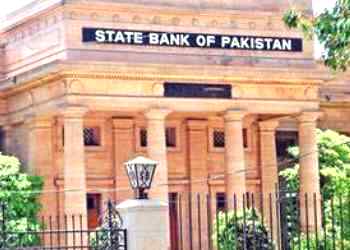KARACHI (NNI): The State Bank of Pakistan (SBP) announced to cut its policy rate by 250 basis points (bps) to 15 percent from 17.5 percent amid calls for a big rate drop.
The decision was taken in a Monetary Policy Committee (MPC) meeting of the central bank chaired by SBP Governor Jameel Ahmad.
According to details, this was the fourth consecutive decrease, totalling a seven percent reduction over this period. The decision was made during a meeting of the Monetary Policy Committee (MPC), chaired by the State Bank of Pakistan (SBP) governor, where the current micro and macroeconomic conditions were thoroughly assessed.
The SBP noted that both local and international economic indicators were reviewed as part of the decision-making process.
According to the central bank, the measures have aimed to stabilise the Pakistani rupee, control inflation, and enhance foreign exchange reserves.
The recent data has shown that the inflation had dropped to its lowest level in four years, standing at 7.2 percent in October. This has led economists to suggest that the SBP was well-positioned to implement a significant interest rate cut.
“At its meeting today, the Monetary Policy Committee (MPC) decided to cut the policy rate by 250 basis points to 15 per cent, effective from November 5, 2024,” the SPB said in a statement, adding that the Committee noted that “inflation has declined faster than expected and has reached close to its medium-term target range in October”.
It highlighted that a “sharp decline in food inflation, favourable global oil prices and absence of expected adjustments in gas tariffs and PDL rates” accelerated the pace of disinflation recently.
The Committee noted the following key developments since its last meeting that could have implications for the macroeconomic outlook.
First, the IMF Board approved Pakistan’s new EFF program, which has reduced uncertainty and improved the prospects for realization of planned external inflows.
Second, the surveys conducted in October showed an improvement in confidence and a reduction in inflation expectations of both consumers and businesses.
Third, the secondary market yields on government securities and KIBOR have declined substantially.
Fourth, tax collection during the first four months of FY25 fell short of target.
Lastly, while the global oil prices have exhibited significant volatility amidst escalating geopolitical tensions, prices of metals and agricultural products have increased notably.
Considering these developments, the Committee viewed the current monetary policy stance as appropriate to achieve the objective of price stability on a durable basis by maintaining inflation within the 5 – 7 percent target range. This will also support macroeconomic stability and help achieve economic growth on a sustainable basis.
Real Sector: The latest data showed a gradual pick-up in economic activity. The initial estimates of major Kharif crops turned out better than the MPC’s earlier expectations. Higher-than-targeted estimates of rice and sugarcane production have more than offset the estimated shortfall in maize and cotton output.
Moreover, the pace of industrial activity is gaining further traction. In particular, textile, food, automobile and allied industries have recorded significant growth during July-August 2024, which is expected to gain further momentum in the coming months.
This assessment is supported by increasing imports of raw materials and machinery, improving business confidence, and easing financial conditions. Better prospects of commodity producing sectors and easing inflationary pressures are also expected to support services sector. Overall, the MPC expects real GDP growth in FY25 to be better than its earlier assessment, while remaining in the range of 2.5 – 3.5 percent.
External Sector: The current account posted a surplus for the second consecutive month in September 2024; narrowing the cumulative deficit to $98 million in Q1-FY25. Despite a substantial increase in imports, robust workers’ remittances and higher exports helped contain the deficit. On the financing side, foreign investment recorded a slight uptick in September.
These developments, along with receipt of the first tranche under the IMF program, helped in further build-up of SBP’s FX reserves to $11.2 billion as on October 25, 2024. Going forward, imports are expected to pick up further amidst increasing economic activity.
The MPC, nonetheless, assessed that relatively higher workers’ remittances and exports will help keep the current account deficit within the projected range of 0 – 1 percent of GDP.
This, together with the realization of planned official inflows, is expected to increase the SBP’s FX reserves to around $13 billion by June 2025.
Fiscal Sector: During Q1-FY25, the fiscal and primary balances posted surpluses of 1.4 percent and 2.4 percent of GDP, respectively.
This improvement is mainly explained by record high SBP profit, which substantially increased the non-tax revenues. In contrast, the FBR tax collection fell short of target during July-October. This implies that achieving the FY25 tax target will require significantly higher growth going forward.
On the expenditure side, lower interest payments are creating a sizable fiscal space that would help keep a check on the overall fiscal deficit. Meeting the targeted primary balance, however, would be challenging.
The MPC emphasized the importance of continued fiscal consolidation to support macroeconomic stability and reiterated the need for fiscal reforms, focusing on broadening the tax base and curtailing PSEs’ losses.
Money and Credit: The broad money (M2) growth increased slightly to 15.2 percent y/y as of October 25, with noticeable changes in its composition since the last MPC meeting. Specifically, the net budgetary borrowing from the banking system declined considerably, while banks’ credit to the non-government sector increased.
After the receipt of SBP profit, the government reduced its borrowing from banks and also initiated buy-back operations of its outstanding debt securities. This created additional room for banks to extend credit to the private sector.
At the same time, there was a significant reduction in SBP’s liquidity injections, which is reflected by a decline in outstanding stock of OMOs. On the liability side, deposits continued to remain the major driver of M2 growth.
Going forward, the MPC viewed that demand for private sector credit may further pick up with easing financial conditions and expected increase in economic activity. Furthermore, in the coming weeks, banks may also extend advances to avoid additional tax on non-compliance of Advances-to-Deposit ratio (ADR) thresholds.
Inflation: Since the last MPC meeting, inflation eased significantly and fell close to its medium-term target range. The headline inflation (y/y) dropped to 6.9 percent in September and 7.2 percent in October, from 9.6 percent in August 2024. Besides contained demand, improved domestic supply of key food commodities, benign global oil prices and favourable base effect accelerated the pace of disinflation in recent months.
The MPC noted that continuation of these factors may bring inflation further down in the next few months. Moreover, underlying inflationary pressures continued to ease, as indicated by a relatively gradual decline in core inflation and moderation in inflation expectations.
Considering these developments, the MPC now expects the average inflation for FY25 to be significantly lower than its previous forecast range of 11.5 – 13.5 percent.
The Committee also assessed that this outlook is subject to multiple risks, such as escalation in the Middle East conflict, recurrence of food inflation pressures, ad hoc adjustments in administered prices and implementation of contingency taxation measures to meet shortfalls in revenue. NNI





































